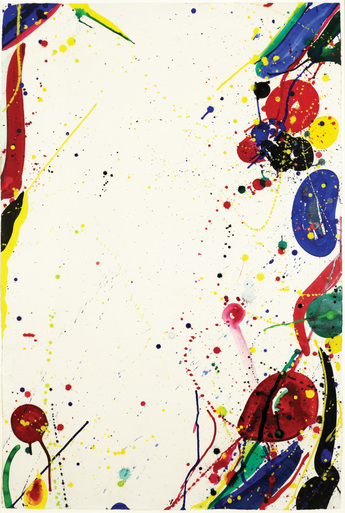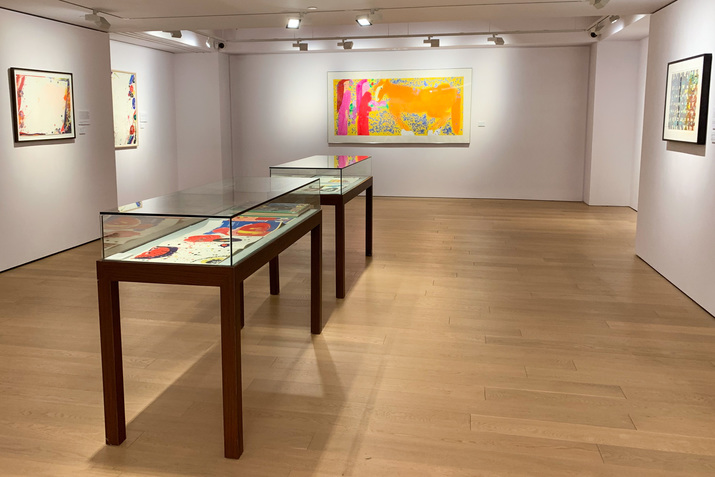-
From Current Issue
-
- Editor’s Letter Fire in the Heart
- Reviews I Gusti Ayu Kadek Murniasih
- Reviews 11th Seoul Mediacity Biennale: “One Escape at a Time”
- Dispatch Networked China
- One on One Monira Al Qadiri on Yukio Mishima
- Essays The rise of independent art spaces in pandemic-era Shanghai
- Features Tuan Andrew Nguyen
- Table of Contents
- Web Exclusives
- Archive
- Subscribe

R
E
V N
E
X
T
WALASSE TING, A Kiss, A Kiss 10012, 1973, acrylic and oil pastel on paper, 56.5 × 76 cm. All images courtesy the artists and Alisan Fine Arts, Hong Kong.
Before they met in the late 1950s, Walasse Ting (1928–2010) and Sam Francis (1923–1994) were already fellow travelers in the unfolding story of postwar abstract painting. Ting had left Shanghai in 1946 for Hong Kong and then traveled onward to Paris in 1952, where, despite speaking no French and living in destitution, he fell in with artists of the tri-city CoBrA (Copenhagen, Brussels, Amsterdam) group, including Karel Appel, Asger Jorn, and Pierre Alechinsky. Seeking more commercial success, Ting then moved to New York in 1957 just as gestural painting was at its peak. Francis, who was born in California five years before Ting and injured on a test flight during World War II, left home for Paris, in 1950, with GI Bill funding and became one of the most commercially successful artists of the era. He too befriended the CoBrA artists, which is how eventually he and Ting crossed paths on the trans-Atlantic artistic circuit between France and the United States in that era.
By all accounts, the two artists had a serious bromance. Along with their personal affinities for one another—they communicated up until Francis’s death in 1994—Ting and Francis shared bombastic artistic tendencies, as illustrated by the exhibition “Celebrating a Friendship” at Alisan Fine Arts. For one, both artists had uniquely bold color palettes. Beginning in the 1950s Francis employed bright primary and secondary colors in his energetic, Japanese ink-painting inspired compositions, reflected at Alisan in works like the gouache-on-paper Bright Ring Drawing (1965), a vertical composition with orbs and ribbons of paint clustered along the right side, and the lithograph Blue Cut Sail (1969), where streaks of colors frame a white central parallelogram. In comparison, Ting favored orange, greens, blues, magenta, and later fluorescent colors in figurative compositions such as Three Girls Chatting (1990s) or Two Ladies with a Horse of Tangerine Colour (1990s). Both artists loved to drip and splatter paint across their compositions in a carefully insouciant-looking manner, even, in Ting’s case, across the surfaces of his sexualized depictions of naked women in works like A Kiss, A Kiss 10012 (1973) or Love Me, Love Me 10041 (1975). Whether this casually artful splattering was the direct influence of Jackson Pollock or Asian traditions of ink painting, Francis’s and Ting’s works capture the Beat-Zen-bohemian ethos of the postwar generation. From today’s vantage, however, Ting’s embrace of the era’s hedonism—particularly in the case of his 1970s nudes—looks far less like the spirit of sexual revolution than the classic objectification of women found in the pages of Hugh Heffner’s Playboy magazine.
Ting began writing poetry in the early 1960s. He roped his friend—whom he called “Big Sam” in letters and postcards, some of which were displayed in a vitrine—into editing a book of his poetry, illustrated with contributions from many of the iconic artists of the day. The resulting publication, 1¢ Life (1964), features 62 colored lithographs spanning abstract expressionists like Joan Mitchell to pop artists Andy Warhol and Tom Wesselman, “uniting tachisme, neo-dadaism, pop art, and all other artistic movements,” wrote the book’s publisher, Swiss gallerist Eberhard W. Kornfield. Ting’s poems were stylized versions of his self-described “raunchy Pidgin English,” mixing ironic humor, repetition, and absurdity, as in “All Kinds of Love”: “husband love wife as long distance call / husband love mistress as rainbow in pocket / girl love man as open dream /. . . richman love big diamond on big steak / . . . judge love everybody wrong / cook love everybody fat / . . . priest love everybody in hell / television love advertising.” 1¢ Life reveals Ting, the artist who proclaimed to “not belong to any group,” as an artist of exactly his moment—his artistic practice poised between abstract expressionism and pop, ink and oil, the Beats and the Hippies, Paris and New York, just like his friend Sam Francis, whom he wrote was the “greatest artist in the world. / loved sas[h]imi and many, many pretty / girls, and many, many canvas.”
HG Masters is ArtAsiaPacific’s deputy publisher and deputy editor.
Sam Francis and Walasse Ting’s “Celebrating a Friendship” is on view at Alisan Fine Arts, Central Gallery, Hong Kong, until March 20, 2021.
To read more of ArtAsiaPacific’s articles, visit our Digital Library.
















